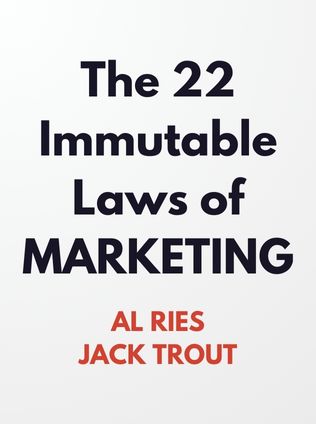
The 22 Immutable Laws of Marketing
Violate Them at Your Own Risk
By Al Ries and Jack Trout
Published 01/1993
About the Author
Al Ries and Jack Trout are two of the most influential figures in the world of marketing. Their careers span decades, during which they have become pioneers of the concept of positioning, a cornerstone of modern marketing strategy. Ries and Trout have authored numerous books together, each contributing significantly to the field, but it is "The 22 Immutable Laws of Marketing" that has cemented their legacy.
Al Ries is particularly known for his work on positioning and branding, concepts that have revolutionized how businesses think about marketing. Jack Trout, who passed away in 2017, was a marketing strategist who helped popularize these ideas alongside Ries. Together, they have influenced generations of marketers, helping them navigate the complex landscape of consumer perception and brand positioning.
Main Idea
The central thesis of "The 22 Immutable Laws of Marketing" is that success in marketing is governed by universal laws, much like the laws of nature. These laws, when followed, can lead to success, but when ignored or violated, they can spell disaster for a brand. Ries and Trout emphasize the importance of understanding and adhering to these laws to achieve and sustain success in the marketplace.
They argue that the most successful companies are not necessarily those with the best products or the largest budgets, but rather those that can position themselves effectively in the minds of consumers. The book outlines 22 principles that businesses should follow to secure a dominant position in their markets and maintain that position over time.
Table of Contents
- Convince Consumers That You’re the Only Viable Option
- Focus Your Message
- Leverage Your Market Position
- Be Consistent
- Be Strategic About Your Overall Marketing Plan
- Get on Top and Stay There
Convince Consumers That You’re the Only Viable Option
Law #1: Be the First in Your Field
Ries and Trout open their book with a powerful assertion: being first in the marketplace gives a brand a significant advantage. They explain that consumers tend to remember the first brand they encounter in a category, which often becomes the default choice. For example, Coca-Cola, as the first cola brand, has remained synonymous with the category despite numerous competitors offering similar or even superior products.
"People remember firsts, and companies that are first to enter their markets are typically more successful than those that follow, even if the latecomers have better products." — Al Ries and Jack Trout
Law #2: If You Can’t Be First, Create a New Category
If another brand has already claimed the top spot, Ries and Trout advise creating a new category where your product can be the first. This strategy allows a company to carve out a unique niche and avoid direct competition with established leaders. An example provided is Charles Schwab, who pioneered the concept of a discount brokerage firm, effectively creating a new category in the financial services industry.
- Create a distinct category for your product.
- Emphasize what sets your brand apart.
- Avoid direct competition with established leaders.
Law #3: Be the First Brand in Consumers’ Minds
Even more important than being first in the market is being first in the minds of consumers. Ries and Trout highlight that the ultimate goal of marketing is to establish a brand as the go-to option for a particular need or desire. This requires not only being first but also maintaining a strong and consistent presence in the consumer's mind.
Sign up for FREE and get access to 1,400+ books summaries.
You May Also Like
The Lean Startup
How Today's Entrepreneurs Use Continuous Innovation to Create Radically Successful Businesses
By Eric RiesWho Moved My Cheese?
An Amazing Way to Deal with Change in Your Work and in Your Life
By Spencer Johnson, M.D.Make Your Bed
Little Things That Can Change Your Life...And Maybe the World
By William H. McRavenThe Ride of a Lifetime
Lessons Learned from 15 Years as CEO of the Walt Disney Company
By Robert Iger



















